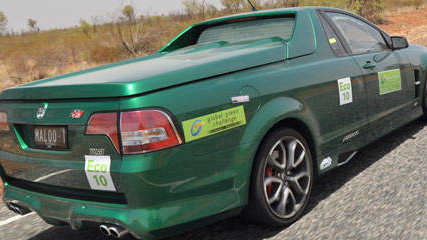HSV Maloo 2010 News

HSV base model ClubSport and Maloo return
Read the article
By Paul Gover · 10 Aug 2012
The base model ClubSport and Maloo join the Holden Special Vehicles' lineup to lead a new value drive and start celebrations for the brand's 25th birthday.
Prices have been pegged at $58,990 for the Maloo ute and $64,990 for the ClubSport, with no loss of punch from their 6.2-litre V8 engines. The only thing missing, compared with the R8 version of the ClubSport, is HSV's high-tech Enhanced Driver Interface system. But the cars do get a new 20-inch alloy wheel called Pentagon.
The born-again ClubSport is much the same as the short-run GXP Commodore but, says HSV managing director Phil Harding, this time it's a "real HSV, all the way around". "We brought the ClubSport back as a GXP a couple of years ago and there was a desire to bring it back in a more solid way. It satisfies a need," Harding tells Carsguide. "It won't be significant volume, but it helps bring people to the marque. It's for the sort of guy who perhaps had an HSV but fell off the ladder and wants to come back."
He admits the pricing is an important reason for the ClubSport and Maloo tweaking, but says HSV is happy with its sales despite the large-car downturn that has hit the Holden Commodore and Ford Falcon. "The biggest change to get to a ClubSport from the R8 is the loss of the EDI system. It helps us get down to a price poiint. With the Luxury Car Tax, once you take something out it has an added effect.
"As for sales, we're about where we wanted to be at this time of the year. We're not panicking and we're doing alright." The new starter car comes as HSV goes public with a range update called MY12.5, although there will be other significant 25th anniversary action. "There is nothing that's public yet. Watch this space," Harding says to deflect any extra questions.
The 12.5 changes are very minor, although the ClubSport R8, Maloo R8 and ClubSport Tourer R8 pick up a power boost to 325 kiloWatts in addition to the 20-inch alloys and leather seat trim. Power in the Senator Signature also improves to 325kW, together with optional 20-inch forged alloys and `Vector' hood scoops and side vents. The 25th anniversay is refected in a special `start-up' screen in the infotainment system, build plate, internal identification and sill plates.

Challenge to economy rules
Read the article
By Karla Pincott · 04 Jun 2010
For the past decade, the event has run from Darwin to Adelaide as a solar car race every second year, but in 2009 the organisers added a production-car ‘Eco Challenge’ category which won a lot of support from car brands - with entries from Mini, Hyundai, Holden, Ford, Suzuki and others - but sparked controversy over the judging and procedures.Competing vehicles were assessed by how much better their crews could drive them in comparison to their official fuel-economy ratings. Since the Green Challenge runs down the Stuart Highway, one of Australia's straightest and flattest roads, the advantage fell instantly to cars with relatively-poor showroom rankings.The road conditions made it much easier to get a percentage improvement on a poor overall rating than a good rating, since running at a constant, low average speed boosts the relative efficiency of big engines.The run down the Red Centre was won by an HSV Maloo R8 ute, which used 7.74litres/100km to fuel its 6.2-litre V8 engine over the entire 3000km route, notching up a 48.76 per cent reduction on its official figure of 15.1litres/100km.However, the Maloo’s consumption was still double that of some of the smaller cars, with the Suzuki Alto, Ford Fiesta Econetic and diesel Mini all coming in under 4litres/100km. So the South Australian Motorsport Board, that oversaw the event, is meeting at the end of next month to analyse and review the event to set the rules and regulations for the next running of the Global Green Challenge in 2011.“Obviously this was the first event of its type, and the board is looking to improve it in every possible way. The event was a success, with plenty of interest – but there is room for improvement,” Challenge spokesman Mike Drewer says.“They will consider whether there need to be changes in procedure, route and even the types of car that enter. There has been a reasonable amount of criticism from the manufacturers who participated, and the board is going to discuss that and make decisions for the future.”Apart from the method of judging, Drewer says the board will also discuss the route and types of competing vehicles – which last year included large car and medium SUV categories.“There was considerable criticism about whether some of the cars were of the types that should be in the Eco Challenge,” Drewer says.“There will be an analysis of whether they are really what the public perceives as ‘eco’ cars – and whether the format should be changed to encourage other kinds of vehicles, such as hybrids. The board wants to improve the event both for participants and for public perception of eco-friendly cars."




